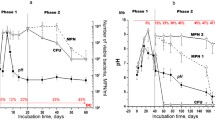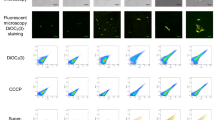Abstract
Biochemical and morphological changes have been studied during transition of Mycobacterium smegmatis cells into their dormant (“nonculturable”) state. A significant fraction of the population of irreversibly “nonculturable” (NC) cells has a thicker cell wall, condensed cytoplasm, and a decreased number of ribosomes. The lipid contents in the NC cells are lower than in the metabolically active cells, with a relatively decreased amount of phospholipid and neutral lipid. Free mycolic acids, which are abundant in metabolically active cells, were not found in the NC cells. The NC forms are also characterized by decreased respiratory activity on endogenous substrates; however, the respiratory chain enzymes retain their activities in the isolated membranes. Activities of the Krebs cycle and glyoxylate cycle enzymes are markedly decreased. Despite a significant decrease in metabolic activity, NC cells possess membrane potential that seems to provide for reversibility of the NC state of mycobacteria, i.e. their capability of reactivating.
Similar content being viewed by others
Abbreviations
- CL:
-
cardiolipin
- DCPIP:
-
2,6-dichlorophenol-indophenol
- H-dB:
-
Hartman’s—de Bont medium
- NC cells:
-
“nonculturable” cells
- PE:
-
phosphatidylethanolamine
- PI:
-
phosphatidylinositol
- PS:
-
phosphatidylserine
References
Mehta, J., and Dutt, A. (1995) Infect. Med., 12, 40–46.
Kaprelyants, A. S., and Kell, D. B. (1993) Appl. Environ. Microbiol., 59, 3187–3196.
Mulyukin, A. L., Sorokin, V. V., Loiko, N. G., Suzina, N. E., Duda, V. I., Vorob’eva, E. A., and El-Registan, G. I. (1996) Mikrobiologiya, 65, 782–789.
Demkina, E. V., Soina, V. S., and El-Registan, G. I. (2000) Mikrobiologiya, 69, 383–388.
Wayne, L. G. (1994) Eur. J. Clin. Microbiol. Infect. Dis., 13, 908–914.
Wayne, L. G., and Hayes, L. G. (1996) Infect. Immun., 64, 2062–2069.
Shleeva, M. O., Bagramyan, K., Telkov, M. V., Mukamolova, G. V., Young, M., Kell, D. B., and Kaprelyants, A. S. (2002) Microbiology, 148, 1581–1591.
Shleeva, M. O., Mukamolova, G. V., Young, M., Williams, H. D., and Kaprelyants, A. S. (2004) Microbiology, 150, 1687–1697.
Mukamolova, G. V., Salina, E. G., and Kaprelyants, A. C. (2008) in National Institute of Allergy and Infectious Diseases, NIH (Georgiev, V., ed.) Vol. 1, Humana Press, pp. 83–90.
Tsai, M. G., Chakravaty, S., Zhu, G., Xu, J., Tanaka, K., Koch, C., Tufariello, J., Flynn, J., and Chan, J. (2006) Cell Microbiol., 8, 218–232.
Kaprelyants, A. S., and Kell, D. B. (1993) J. Microbiol. Meth., 17, 115–122.
Ito, S., and Karnovsky, M. (1969) J. Cell Biol., 39, 168–169.
Newman, G. R., Jasani, B., and Williams, E. D. (1983) Histochem. J., 15, 543–555.
Reynolds, E. S. (1963) J. Cell Biol., 17, 208–212.
Salina, E. G., Shleeva, M. O., Vostroknutova, G. N., and Kaprelyants, A. S. (2005) Clin. Microbiol. Infect., 11, 645.
Mukamolova, G. V., Yanopolskaya, N. D., Votyakova, T. V., Popov, V. I., Kaprelyants, A. S., and Kell, D. B. (1995) Arch. Microbiol., 163, 373–379.
Kaneda, K., Naito, S., Imaizumi, S., Yano, I., Mizuno, S., Tomiyasu, I., Baba, T., Kusunose, E., and Kusunose, M. (1986) J. Clin. Microbiol., 24, 1060–1070.
Suzina, N. E., Mulyukin, A. L., Kozlova, A. N., Shorokhova, A. P., Dmitriev, V. V., Barinova, E. S., Mokhova, O. N., El-Registan, G. I., and Duda, V. I. (2004) Mikrobiologiya, 73, 516–529.
Mukamolova, G. V., Kormer, S. S., Yanopol’skaya, N. D., and Kaprelyants, A. S. (1995) Mikrobiologiya, 63, 341–346.
Artsatbanov, V. Yu., Tikhonova, G. V., and Ostrovskii, D. N. (1983) Biokhimiya, 48, 1568–1579.
Author information
Authors and Affiliations
Corresponding author
Additional information
Original Russian Text © E. G. Salina, Yu. A. Zhogina, M. O. Shleeva, G. M. Sorokoumova, A. A. Selishcheva, A. S. Kaprelyants, 2010, published in Biokhimiya, 2010, Vol. 75, No. 1, pp. 88–98.
Rights and permissions
About this article
Cite this article
Salina, E.G., Zhogina, Y.A., Shleeva, M.O. et al. Biochemical and morphological changes in dormant (“Nonculturable”) Mycobacterium smegmatis cells. Biochemistry Moscow 75, 72–80 (2010). https://doi.org/10.1134/S0006297910010098
Received:
Revised:
Published:
Issue Date:
DOI: https://doi.org/10.1134/S0006297910010098




